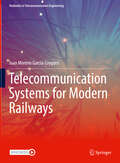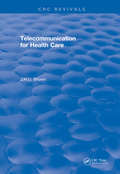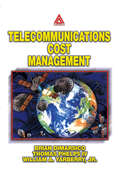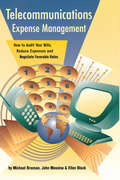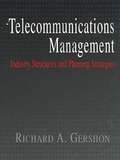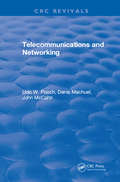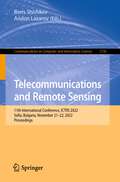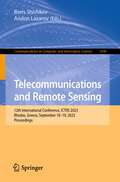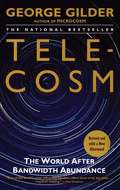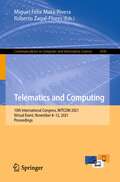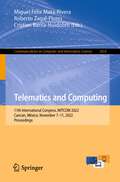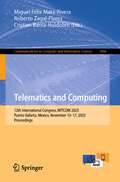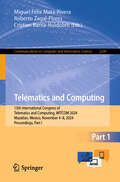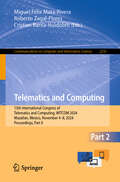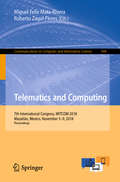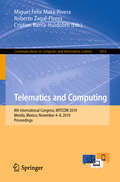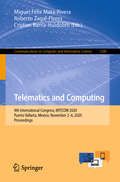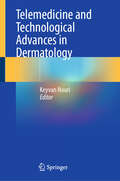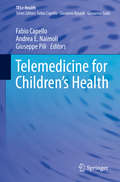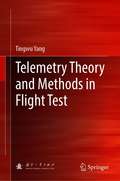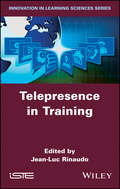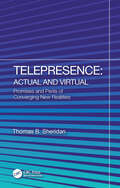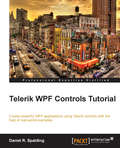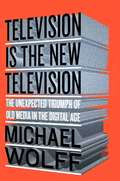- Table View
- List View
Telecommunication Systems for Modern Railways (Textbooks in Telecommunication Engineering)
by Juan Moreno García-LoygorriThis textbook provides a comprehensive treatment of railway communications systems and their ever-evolving interconnectivity, smart systems, and complex grids. The author first provides an introduction to railways and goes on to detail wayside networks, onboard networks, safety systems, and services that rely on these networks. In particular, the book covers application aspects, including network and physical layer, maintenance, and technologies that will shape the railway of the future. The book also covers rolling stock networks and systems and details the railway ecosystem that will help people new to the topic understand the core material. The book is oriented to educational purposes in classes such as Intelligent Transportation Systems or Communication Systems Architectures and also for practicing railway engineers. The textbook features supplementary material including homework problems, exercises and more.
Telecommunication for Health Care (CRC Press Revivals)
by J.H.U. BrownThere are relatively few references in this volume. This occurs for two reasons. In the first place, the Federal government has sponsored most of the communication experiments in health care and many of the results are buried in government reports. Some of these have been included. Secondly, although very large projects have been initiated and some may set a pattern for future health care, they have not attracted merited attention.
Telecommunications Cost Management
by William A. Yarberry Jr. Brian DiMarsico Thomas Phelps IVBusy decision-makers need the specifics quickly, without plowing through details that do not affect the economics of a project. Telecommunications Cost Management presents the key facts up front, with sample calculations for broadband, local access, equipment, and service alternatives. It provides a blueprint for cost reduction across all major technologies - from frame relay to IP telephony to contract recommendations. The text presents scenarios showing the effect of different architectural strategies for both voice and data communications. An Architectural Review lists alternatives to the traditional PBX and discusses how to minimize local access costs.
Telecommunications Expense Management: How to Audit Your Bills, Reduce Expenses, and Negotiate Favorable Rates
by Michael Brosnan John MessinaThis straightforward book will provide you with the insight necessary to save your organization revenue through the processes of bill auditing, expense reduction, and savvy contract negotiations. Information technology professionals will find the authors' suggestions useful, and yet uncomplicated to implement. After you have used their suggestions
Telecommunications Management
by Richard GershonWith today's communications industry experiencing major changes on an almost daily basis, media managers must have a clear understanding of the different delivery platforms, as well as a grasp of critical management, planning, and economic factors in order to stay current and move their organizations forward. Telecommunications Management helps current and future media professionals understand the relationship and convergence patterns between the broadcast, cable television, telephony, and Internet communication industries. Author Richard A. Gershon examines telecommunications industry structures and the management practices and business strategies affecting the delivery of information and entertainment services to consumers. He brings in specialists to present the finer points of management and planning responsibilities. Case studies from the International Radio and Television Society (IRTS) competition supplement the main text and offer an invaluable perspective on management issues. Developed for students in telecommunications management, electronic media management, and telecommunication economics, this volume also serves as a practical reference for the professional manager.
Telecommunications and Networking (Computer Science And Engineering Ser.)
by Udo W. PoochAs the dividing line between traditional computing science and telecommunications quickly becomes blurred or disappears in today's rapidly changing environment, there is an increasing need for computer professionals to possess knowledge of telecommunications principles. Telecommunications and Networking presents a comprehensive overview of the interaction and relationship between telecommunications and data processing. The book's early chapters cover basic telecommunications vocabulary, common nomenclature, telecommunications fundamentals, as well as the important relationships among coding, error detection and correction, and noise. Later chapters discuss such topics as switching, timing, topological structures, routing algorithms, and teleprocessing. Other topics covered in detail include specific concerns inherent to computer communications, such as protocols, error detection and correction, network monitoring and security, and system validation.System designers and programmers can no longer be effective simply by understanding the tradeoffs between hardware and software. Telecommunications and Networking provides both computing professionals and students the fundamental computer communications concepts necessary to function in today's computer industry.
Telecommunications and Remote Sensing: 11th International Conference, ICTRS 2022, Sofia, Bulgaria, November 21–22, 2022, Proceedings (Communications in Computer and Information Science #1730)
by Boris Shishkov Andon LazarovThis book contains the proceedings of ICTRS 2022 (the 11th International Conference on Telecommunications and Remote Sensing), held in Sofia, Bulgaria, on 21-22 November 2022. ICTRS is an annual event that brings together researchers and practitioners interested in telecommunications, remote sensing, and their societal implications. As mentioned already, ICTRS is essentially leaning toward telecommunications and remote sensing plus relevant societal implications. In this, ICTRS 2022 addresses a large number of research areas and topics, such as: Wireless Telecommunications and Networking; Electromagnetic Waves and Fields; Electronics and Photonics; Remote Sensing and Data Interpretation; Remote Sensing and Internet-Of-Things; and Societal Impact.
Telecommunications and Remote Sensing: 12th International Conference, ICTRS 2023, Rhodes, Greece, September 18-19, 2023, Proceedings (Communications in Computer and Information Science #1990)
by Boris Shishkov Andon LazarovThis book contains the proceedings of ICTRS 2023, the 12th International Conference on Telecommunications and Remote Sensing, held in a hybrid format in Rhodes, Greece, in September 2023. ICTRS is an annual event that brings together researchers and practitioners interested in telecommunications, remote sensing, and their societal implications.The 7 full papers and 4 short papers were thoroughly reviewed and selected from the 24 qualified submissions. ICTRS 2023 addresses a large number of research areas and topics, such as: wireless telecommunications and networking; electromagnetic waves and fields; electronics and photonics; remote sensing and data interpretation; remote sensing and Internet-of-Things; and societal impact.
Telecosm: How Infinite Bandwidth Will Revolutionize Our World
by George GilderThe computer age is over. After a cataclysmic global run of thirty years, it has given birth to the age of the telecosm -- the world enabled and defined by new communications technology. Chips and software will continue to make great contributions to our lives, but the action is elsewhere. To seek the key to great wealth and to understand the bewildering ways that high tech is restructuring our lives, look not to chip speed but to communication power, or bandwidth. Bandwidth is exploding, and its abundance is the most important social and economic fact of our time. George Gilder is one of the great technological visionaries, and "the man who put the 's' in 'telecosm'" (Telephony magazine). He is equally famous for understanding and predicting the nuts and bolts of complex technologies, and for putting it all together in a soaring view of why things change, and what it means for our daily lives. His track record of futurist predictions is one of the best, often proving to be right even when initially opposed by mighty corporations and governments. He foresaw the power of fiber and wireless optics, the decline of the telephone regime, and the explosion of handheld computers, among many trends. His list of favored companies outpaced even the soaring Nasdaq in 1999 by more than double. His long-awaited Telecosm is a bible of the new age of communications. Equal parts science story, business history, social analysis, and prediction, it is the one book you need to make sense of the titanic changes underway in our lives. Whether you surf the net constantly or not at all, whether you live on your cell phone or hate it for its invasion of private life, you need this book. It has been less than two decades since the introduction of the IBM personal computer, and yet the enormous changes wrought in our lives by the computer will pale beside the changes of the telecosm. Gilder explains why computers will "empty out," with their components migrating to the net; why hundreds of low-flying satellites will enable hand-held computers and communicators to become ubiquitous; why television will die; why newspapers and magazines will revive; why advertising will become less obnoxious; and why companies will never be able to waste your time again. Along the way you will meet the movers and shakers who have made the telecosm possible. From Charles Townes and Gordon Gould, who invented the laser, to the story of JDS Uniphase, "the Intel of the Telecosm," to the birthing of fiberless optics pioneer TeraBeam, here are the inventors and entrepreneurs who will be hailed as the next Edison or Gates. From hardware to software to chips to storage, here are the technologies that will soon be as basic as the air we breathe.
Telematics and Computing: 10th International Congress, WITCOM 2021, Virtual Event, November 8–12, 2021, Proceedings (Communications in Computer and Information Science #1430)
by Roberto Zagal-Flores Miguel Félix Mata-RiveraThis book constitutes the thoroughly refereed proceedings of the 10th International Congress on Telematics and Computing, WITCOM 2021, held in November 2021. Due to the COVID-19 pandemic the conference was held online. The 12 full papers and 7 short papers in this volume were carefully reviewed and selected from 48 submissions. The papers are focused on the topics of deep and machine learning, cybersecurity, wireless networks, computer vision, communications, and education applied to different sceneries of study and COVID-19.
Telematics and Computing: 11th International Congress, WITCOM 2022, Cancún, México, November 7–11, 2022, Proceedings (Communications in Computer and Information Science #1659)
by Roberto Zagal-Flores Miguel Félix Mata-Rivera Cristian Barria-HuidobroThis book constitutes the proceedings of the 11th International Congress on Telematics and Computing, WITCOM 2022, held in Cancún, México, in November 2022. The 30 full papers presented in this volume were carefully reviewed and selected from 73 submissions. The papers are focused on the topics of artificial intelligence techniques, Data Science, Blockchain, environment Monitoring, Cybersecurity, Education, and software for communications protocols.
Telematics and Computing: 12th International Congress, WITCOM 2023, Puerto Vallarta, Mexico, November 13–17, 2023, Proceedings (Communications in Computer and Information Science #1906)
by Roberto Zagal-Flores Miguel Félix Mata-Rivera Cristian Barria-HuidobroThis book constitutes the proceedings of the 12th International Congress on Telematics and Computing, WITCOM 2023, held in Puerto Vallarta, Mexico, in November 2023. The 35 full papers presented in this volume were carefully reviewed and selected from 88 submissions. The papers are focused on the topics of artificial intelligence techniques, data science, blockchain, environment monitoring, cybersecurity, education, and software for communications protocols.
Telematics and Computing: 13th International Congress of Telematics and Computing, WITCOM 2024, Mazatlan, Mexico, November 4–8, 2024, Proceedings, Part I (Communications in Computer and Information Science #2249)
by Roberto Zagal-Flores Miguel Félix Mata-Rivera Cristian Barria-HuidobroThis two-volume set constitutes the refereed proceedings of the 13th International Conference on Telematics and Computing , WITCOM 2024, which took place in Mazatlan, Mexico, during November 4–8, 2024. The 41 full papers presented in this volume were carefully reviewed and selected from 91 submissions. The papers focus on the topics of environment monitoring, information systems, IoT, education, artificial intelligence techniques, cybersecurity, data science, and energy, with applications to different case of study.
Telematics and Computing: 13th International Congress of Telematics and Computing, WITCOM 2024, Mazatlan, Mexico, November 4–8, 2024, Proceedings, Part II (Communications in Computer and Information Science #2250)
by Roberto Zagal-Flores Miguel Félix Mata-Rivera Cristian Barria-HuidobroThis two-volume set constitutes the refereed proceedings of the 13th International Conference on Telematics and Computing , WITCOM 2024, which took place in Mazatlan, Mexico, during November 4–8, 2024. The 41 full papers presented in this volume were carefully reviewed and selected from 91 submissions. The papers focus on the topics of environment monitoring, information systems, IoT, education, artificial intelligence techniques, cybersecurity, data science, and energy, with applications to different case of study.
Telematics and Computing: 7th International Congress, WITCOM 2018, Mazatlán, Mexico, November 5-9, 2018, Proceedings (Communications in Computer and Information Science #944)
by Miguel Felix Mata-Rivera Roberto Zagal-FloresThis book constitutes the thoroughly refereed proceedings of the 7th International Congress on Telematics and Computing, WITCOM 2018, held in Mazatlán, Mexico in November 2018.The 23 full papers presented in this volume were carefully reviewed and selected from 57 submissions. They present and organize the knowledge from within the field of telematics and security, data analytics and Machine Learning, IoT and mobile computing.
Telematics and Computing: 8th International Congress, WITCOM 2019, Merida, Mexico, November 4–8, 2019, Proceedings (Communications in Computer and Information Science #1053)
by Miguel Felix Mata-Rivera Roberto Zagal-Flores Cristian Barría-HuidobroThis book constitutes the thoroughly refereed proceedings of the 8th International Congress on Telematics and Computing, WITCOM 2019, held in Merida, Mexico, in November 2019. The 31 full papers presented in this volume were carefully reviewed and selected from 78 submissions. The papers are organized in topical sections: GIS & climate change; telematics & electronics; artificial intelligence & machine learning; software engineering & education; internet of things; and informatics security.
Telematics and Computing: 9th International Congress, WITCOM 2020, Puerto Vallarta, Mexico, November 2–6, 2020, Proceedings (Communications in Computer and Information Science #1280)
by Roberto Zagal-Flores Miguel Félix Mata-Rivera Cristian Barria-HuidobroThis book constitutes the thoroughly refereed proceedings of the 9th International Congress on Telematics and Computing, WITCOM 2020, held in Puerto Vallarta, Mexico, in November 2020. Due to the COVID-19 pandemic the conference was held online. The 28 full papers and 3 short papers in this volume were carefully reviewed and selected from 79 submissions. The papers are focused on the topics of deep and machine learning, cybersecurity, wireless networks, computer vision, communications, and education applied to different sceneries of study and COVID-19.
Telemedicine and Technological Advances in Dermatology
by Keyvan NouriThis book provides a practically applicable guide to the latest applications of telemedicine, imaging technology and artificial intelligence (AI) in dermatology. It introduces these subjects in a clear easy-to follow format ideal for those learning about using technology in modern dermatologic practice. Overviews of the current applications are provided along with detailed discussion of their potential future uses and drawbacks. Emphasis is placed on providing insight into the latest diagnostic non-invasive imaging alternatives to skin biopsy, such as high-resolution ultrasonography, and how AI can enable rapid diagnosis of skin cancer along with its impact in dermatopathology. Telemedicine and Technological Advances in Dermatology reviews the fundamental aspects of telemedicine and how AI is impacting diagnostic and treatment methods in the field. With detailed information on how to apply the latest imaging techniques provided, this book is essential reading for all dermatologists and healthcare professionals who manage diseases of the skin, while providing insights to informaticians and data scientists on applying these technologies to the skin.
Telemedicine for Children's Health
by Fabio Capello Andrea E. Naimoli Giuseppe PiliThis book describes in detail the potential role of ICT and electronic systems, together with the application of Web 2. 0 technologies, in telepediatrics and child health. Rather than simply proposing engineering solutions that may soon become outdated, it is designed to address those real needs that telemedicine and developers are asked to meet. The orientation of the book is very much toward primary care and both low and high-income settings as well as extreme or complex scenarios are considered. The first two sections of the book describe different fields of application, such as the community, the hospital and children with chronic illnesses or special needs, and examine technical issues. The use of telemedicine in delivery of care in extreme rural settings and developing countries is then discussed, with attention also to major emergencies and humanitarian crises. The closing chapters consider the role of modern technologies in the education of caregivers who work with children. Child health is a crucial issue in both industrialized and developing countries. Telemedicine for Children's Health will be an excellent guide to the potential value of telemedicine devices in reducing the burden for children and parents and in offering quick and concrete solutions in low-resource scenarios.
Telemetry Theory and Methods in Flight Test
by Tingwu YangThis book describes systematically telemetry theory and methods for aircraft in flight test. Test targets of telemetry in flight test include airplanes, helicopters, unmanned aerial vehicles, aerostatics, carrier-based aircraft, airborne equipment (systems), weapon systems, (powered) aircraft scale models, aircraft external stores (e.g., nacelle, auxiliary tanks), and ejection seats and so on. The book collects the author's telemetry research work and presents methods that have been verified in real-world tests. The book has eight chapters: the first three discuss the theoretical basis of telemetry, while the other five focus on the methods used in flight tests.Unlike other professional textbooks, this book describes the practical telemetry theory and combines theory and engineering practice to offer a comprehensive and systematic overview of telemetry in flight test for readers.
Teleportation: The Impossible Leap
by David DarlingAn examination of developments in quantum physics which suggest that some form of matter transmission may be possible in the future.
Telepresence in Training
by Jean-Luc RinaudoThe different forms of telepresence in education, in distance learning, in student support, in the use of learning environments or even at the heart of robot systems, are developed in universities and higher education facilities specializing in professional training. They constitute opportunities to reform arguments and give rise to important questions: how should we think about the hierarchy of presence and absence in these techniques in order to make possible “the presence of the absent”? What is the effect on mediation processes? On the perception of the body and on identity? How does it transform collaborative work? Telepresence in Training brings together research that attempts to answer these questions by using studies and practical supports from higher education, with regards to teacher training and telepresence robots in France, Belgium, Switzerland and Quebec.
Telepresence: Promises and Perils of Converging New Realities
by Thomas B. SheridanTelepresence: Actual and Virtual explores the history of telepresence from the 1948 developments of master–slave manipulation, through to current telepresence technology used in space, undersea, surgery and telemedicine, operations in nuclear and other hazardous environments, policing and surveillance, agriculture, construction, mining, warehousing, education, amusement, social media, and other contexts. It also describes the various operator hand and body controls and the corresponding telerobotic actuation of robotic hands, arms, and locomotion. This book reviews the sensing and control technology, its history and likely future, and discusses the many research and policy issues that are raised. The book also takes up key questions relating to social and ethical issues, given that a person’s mechanical reach is becoming unlimited, enabling one to perform mischievous or harmful acts without identification, and what that portends for future developments in telepresence, including regulation and recommended directions of development. The primary audience for this book is professionals interested in human–robot interaction, human factors engineering, virtual reality, applications to space and undersea exploration, telemedicine and telesurgery, firefighting, mechanized agriculture, policing, drone surveillance, warehouse parts' fetching, mining, and military operations.
Telerik WPF Controls Tutorial
by Daniel R. SpaldingThis book follows a hands-on, example-based approach to demonstrate how to efficiently integrate Telerik RadControls within a WPF application. This book is for anyone who plans to use Telerik controls within a WPF application. The reader should have an existing knowledge of C#, SQL, and object-oriented design. The book will focus on the use of objects to populate the controls, so knowledge of object-oriented design is very important.
Television Is the New Television
by Michael Wolff"The closer the new media future gets, the further victory appears." --Michael WolffThis is a book about what happens when the smartest people in the room decide something is inevitable, and yet it doesn't come to pass. What happens when omens have been misread, tea leaves misinterpreted, gurus embarrassed?Twenty years after the Netscape IPO, ten years after the birth of YouTube, and five years after the first iPad, the Internet has still not destroyed the giants of old media. CBS, News Corp, Disney, Comcast, Time Warner, and their peers are still alive, kicking, and making big bucks. The New York Times still earns far more from print ads than from digital ads. Super Bowl commercials are more valuable than ever. Banner ad space on Yahoo can be bought for a relative pittance.Sure, the darlings of new media--Buzzfeed, HuffPo, Politico, and many more--keep attracting ever more traffic, in some cases truly phenomenal traffic. But as Michael Wolff shows in this fascinating and sure-to-be-controversial book, their buzz and venture financing rounds are based on assumptions that were wrong from the start, and become more wrong with each passing year. The consequences of this folly are far reaching for anyone who cares about good journalism, enjoys bingeing on Netflix, works with advertising, or plans to have a role in the future of the Internet.Wolff set out to write an honest guide to the changing media landscape, based on a clear-eyed evaluation of who really makes money and how. His conclusion: the Web, social media, and various mobile platforms are not the new television. Television is the new television.We all know that Google and Facebook are thriving by selling online ads--but they're aggregators, not content creators. As major brands conclude that banner ads next to text basically don't work, the value of digital traffic to content-driven sites has plummeted, while the value of a television audience continues to rise. Even if millions now watch television on their phones via their Netflix, Hulu, and HBO GO apps, that doesn't change the balance of power. Television by any other name is the game everybody is trying to win--including outlets like The Wall Street Journal that never used to play the game at all.Drawing on his unparalleled sources in corner offices from Rockefeller Center to Beverly Hills, Wolff tells us what's really going on, which emperors have no clothes, and which supposed geniuses are due for a major fall. Whether he riles you or makes you cheer, his book will change how you think about media, technology, and the way we live now.From the Hardcover edition.
